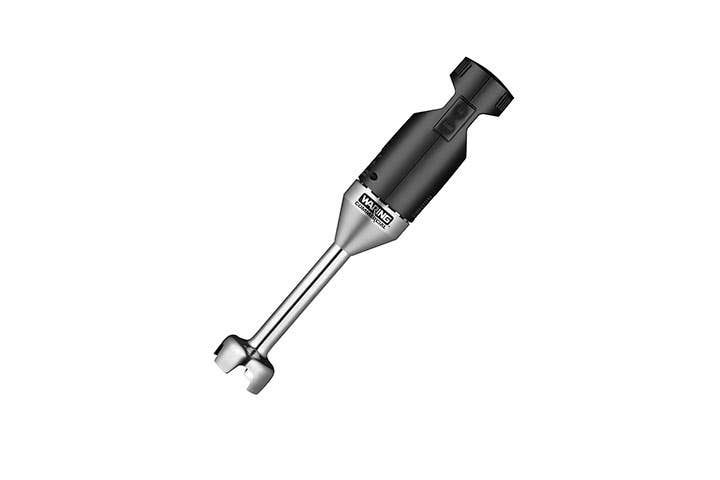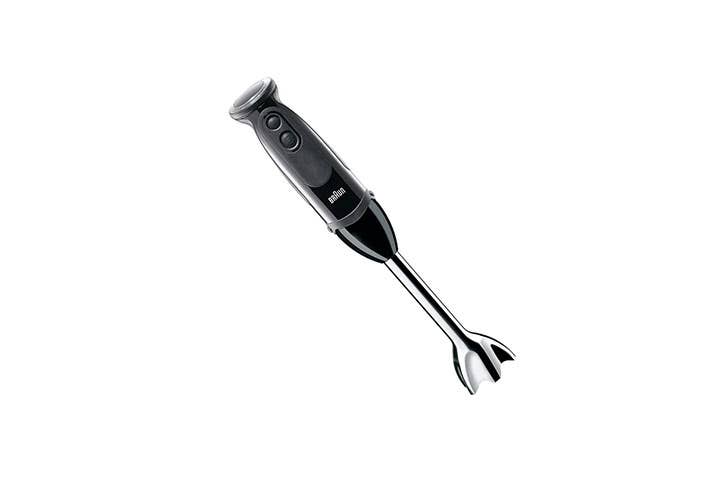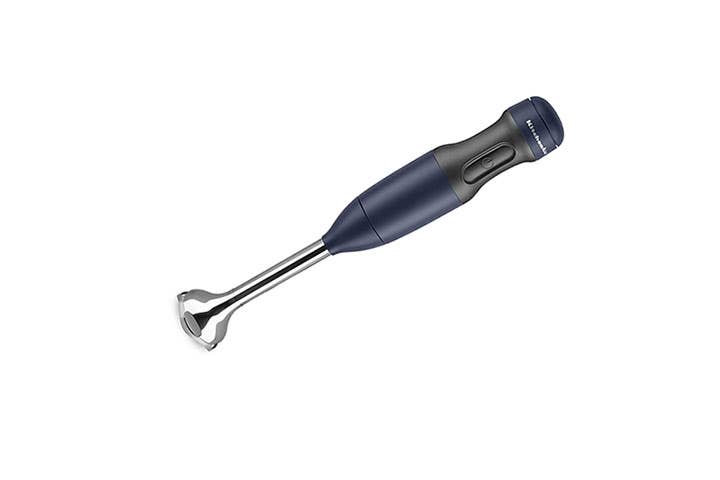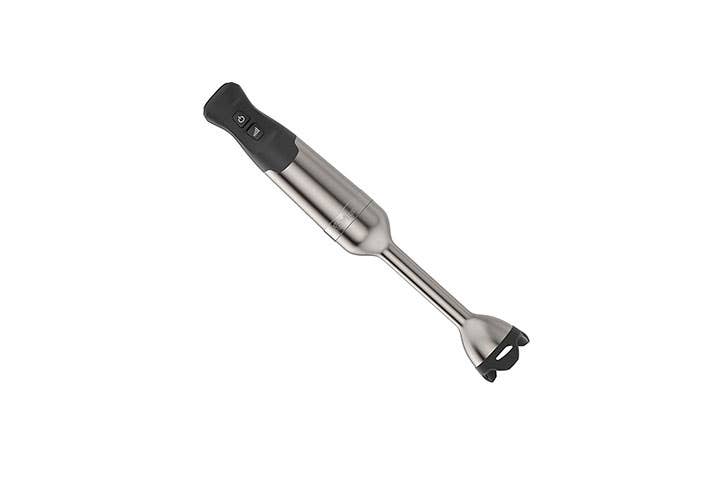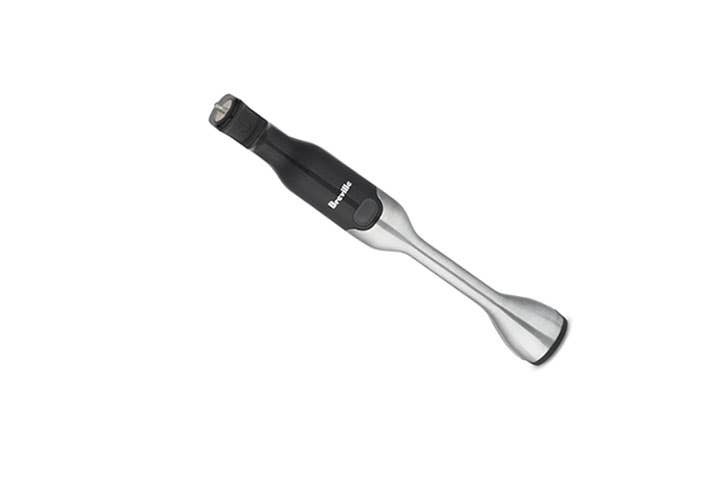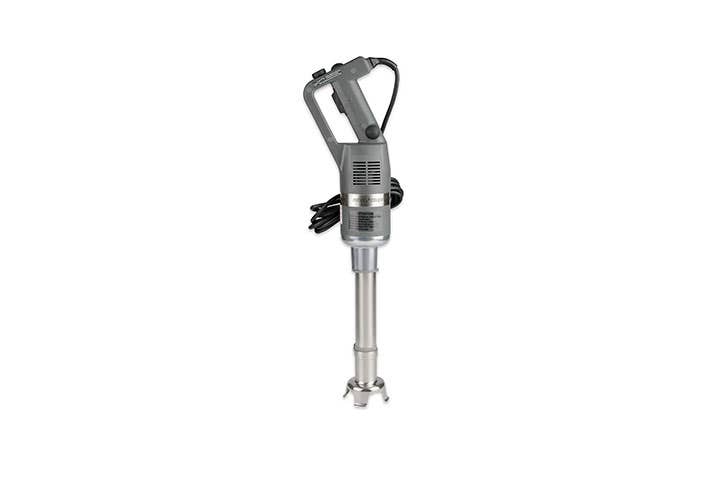The Best Immersion Blenders Make Light Work of Everything From Gazpacho to Hummus
Petite but powerful.
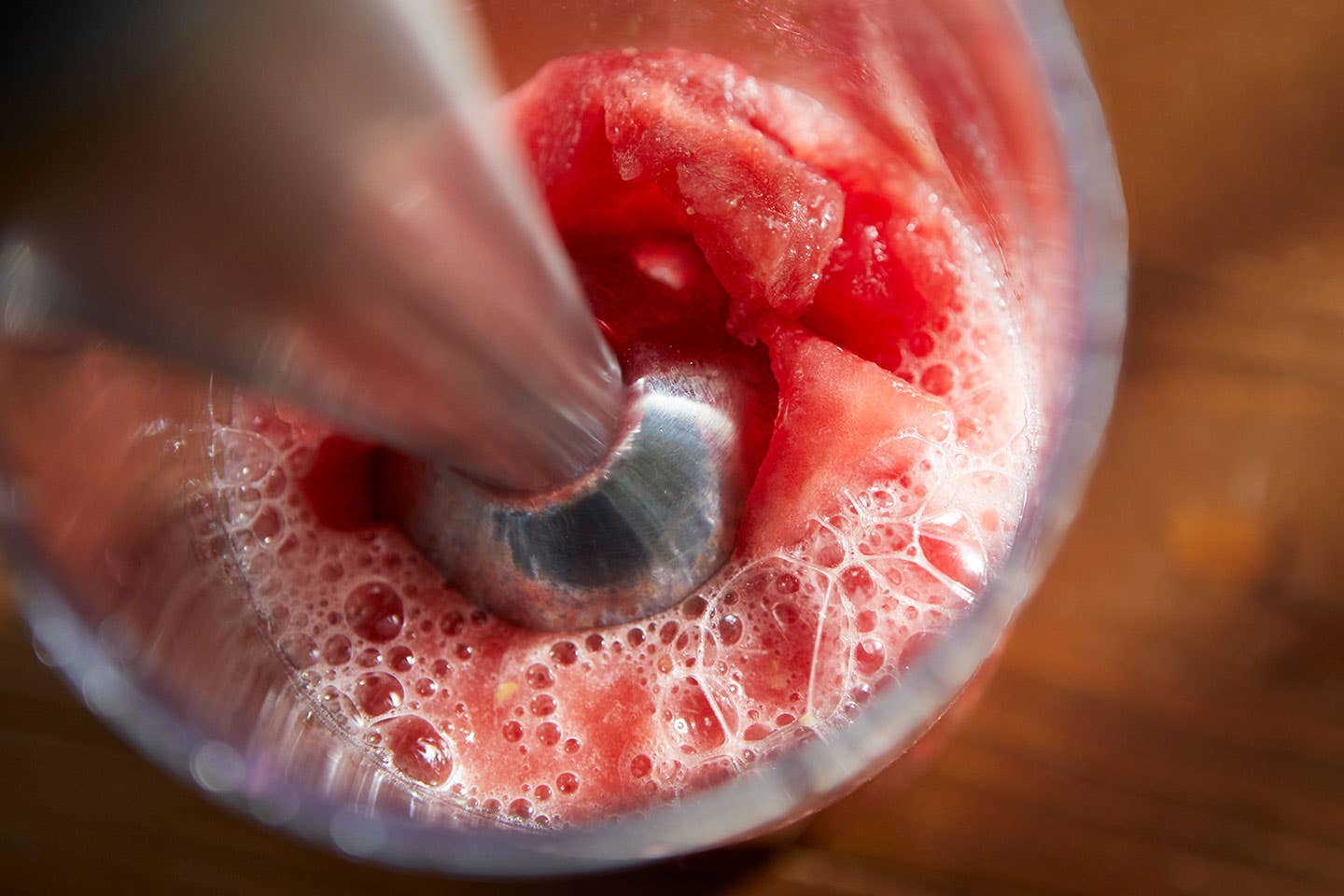
Blenders are kitchen workhorses, whether you’re whipping up nourishing breakfast smoothies or creamy salad dressings worth getting genuinely excited about. But full-sized versions can be clunky, noisy, and messy. Luckily, their sleeker cookware cousin, the immersion blender, avoids these issues.
For the uninitiated, an immersion blender, also called a hand blender or stick blender, streamlines the process because it’s usually inserted directly into a mixing bowl or pot filled with whatever you’re pulverizing instead of putting the ingredients into a blender, eliminating one more thing to clean (and store when not in use). It typically has “a big grip on top, is easy to turn on, and you can adjust the speed,” explains chef Radu Grigore of Elaia Estiatorio in Bridgehampton, New York, who likes to use the tool for making large quantities of purées, soups, and sauces both at home and on the line.
Immersion blenders are compact, nimble powerhouses that can really minimize cleanup, too. “Using an immersion blender saves me a mess because there’s one less thing to wash,” says Jason Goldstein, food blogger and recipe developer for Chop Happy. “Instead of pouring tomato soup or sauce from a hot pot into a blender, the immersion blender goes in the pot, and you’re done!”
Ahead, Grigore, Goldstein, and a few other culinary pros share their seasoned picks for the best immersion blender for every type of cook and budget, plus savvy tips for getting the most out of this versatile tool.
Our Top Picks
- Best Overall: Waring Quik Stik Immersion Blender
- Runner-Up: Braun Multiquick Vario Hand Blender
- Best Value: KitchenAid 2-Speed Hand Blender
- Best Ergonomic: Vitamix Immersion Blender
- Best Multipurpose: Breville Control Grip Immersion Blender
- Best Splurge: Robot Coupe Hand Held Compact Power Mixer
Best Overall: Waring Quik Stik Immersion Blender
Wattage: 100 | Number of speeds: 2 | Accessories: 0
Best Overall
Pros
- Wide range of power and sizes
- Professional kitchen caliber
- Can tackle large capacities
Cons
- One piece; wand doesn’t separate for washing
- No accessories
Why we chose it: Waring’s reputation and pro kitchen chops in a home cooking-suited size.
Both Grigore and fellow Long Island chef Eric Miller of Rita Cantina in East Hampton, New York rave about Waring’s immersion blenders, which are available in an extensive range of sizes and power levels. For pro kitchen-caliber power and reputation in a more compact scale suited to home cooking, consider this model, which has a 7-inch stainless steel blade, a. 2-speed, high-efficiency motor, a 6-foot-long cord, and a relatively generous 3-gallon (aka 12-quart) capacity. Note that it doesn’t come with any accessories (not even a blade guard), which is fairly typical of professional-grade appliances.
Runner-Up: Braun Multiquick Vario Hand Blender
Wattage: 400 | Number of speeds: 21 | Accessories: 4
Best Runner-up
Pros
- Impressive number of speeds
- Affordable
- Wand is designed for anti-splash
Cons
- Can be fiddly to swap attachments
Why we chose it: With 21 speeds and a number of accessories, the Braun Multiquick Vario is a kitchen workhorse.
Chef Glenn Rolnick, director of culinary operations at Virgil's Real Barbecue and Carmine's in NYC, says the brand’s older MR430 HC model is his go-to at home, but this newer option in the brand’s Multiquick range is worth considering. The popular 400-watt blender has nearly 3,000 ratings and an average 4.5 stars on Amazon. The brand’s signature PowerBell Anti-Splash shaft helps keep ingredients where they belong mid-blending, and there are an impressive 21 speed settings, plus an ultra-fast “turbo” option to quickly blitz ingredients. Like the innovative-for-its-time MR430 HC, this option comes with a blender, whisk, chopper, masher, and beaker. Fine with less accessories and speeds to maneuver? The MQ505 model, equipped with two speeds plus a whisk attachment and beaker, comes at a slightly lower price point.
Best Value: KitchenAid 2-Speed Hand Blender
Wattage: 200 | Number of speeds: 2 | Accessories: 1
Best Value
Pros
- Straightforward and simple to operate
- Available in several colors
- Wand is dishwasher-safe
Cons
- Just one accessory: a blending jar
Why we chose it: This 2-speed blender offers serious power (and is easy to use and clean) at a lower price point.
Goldstein swears by this KitchenAid model, which has a removable 8-inch blending arm with a fixed S-blade, a soft-grip handle, and a lidded 3-cup blending jar to easily store leftover sauces or dressings. Reviews rave that it can blitz down ice (and tackle soap-making, should that ever crop up), is easy to clean, and surprisingly powerful for its affordable price point. It also comes in cheery hues like aqua and cherry red to brighten up your countertop.
Best Ergonomic: Vitamix Immersion Blender
Wattage: 625 | Number of speeds: 5 | Accessories: 0
Most Comfortable To Use
Pros
- Powerful motor
- Solid construction
- Pressure-sensitive variable speed button
Cons
- An investment
Why we chose it: An immersion blender designed to be comfortable to hold and operate.
Writer and product tester extraordinaire Jarrett Melendez loves Vitamix’s immersion blender, so much so that he says it’s the best one he’s ever used—either in pro kitchens or at home. He loves how comfortable the handle is and how solid the locking mechanism feels, as well as the pressure-sensitive variable speed controls. The blender’s slender bell and wand fit into any container that has a mouth of 3 inches or wider, and it tackles fibrous fruits and vegetables with ease. Add a 3-year warranty into the mix and Vitamix’s take on the immersion blender is hard to pass up.
Best Multipurpose: Breville Control Grip Immersion Blender
Wattage: 280 | Number of speeds: 15 | Accessories: 3
Most Comfortable To Use
Pros
- Easy grip handle
- Oversized blending jar
Cons
- Depth often requires extending the bake time
- Plastic accessories can become fragile over time
- Large wand doesn’t fit into every container, like Ball jars
Why we chose it: With the accompanying whisk, chopper blades, and storage bowl, this immersion blender does more than average in the kitchen.
The major distinction of this smartly designed blender from espresso mainstay Breville? Its unique rubber handle and grip, which positions the power button in a smart side spot. No more contorting your fingers at awkward angles while blending! Plus, a bigger-than-usual jar (clocking in at 42 ounces) makes it easy to store leftovers or meal-prepped soups. If you’re looking for accessories, it has a whisk and a chopper, too.
Best Splurge: Robot Coupe Hand Held Compact Power Mixer
Wattage: 280 | Number of speeds: Self-regulating | Accessories: 0
Best Splurge
Pros
- Self-regulating speed
- Can handle large capacities
- Removable bell and blade for cleaning
Cons
- Very expensive
Why we chose it: All the features are built right into this immersion blender that is a favorite in professional kitchens.
If you’re already an immersion blender devotee looking for an upgrade, consider this pro-grade stainless steel option from Robot Coupe. Miller and Rolnick both recommend this brand. There aren’t any attachments typically found in home cooking-centric versions because the bells and whistles are baked into the design of the blender itself. It self-regulates between different speeds (from 5,000 to 10,000 rotations per minute) to create smooth purées automatically. Also, the blade is removable, and so is the exterior bell surrounding the blade, so it’s a cinch to clean; there’s even an included tool to safely detach both parts. Plus, it comes with a wall-mounted holder for true blender superfans who want safe and easy access without needing to open a cabinet. Miller’s go-to is this 16-quart capacity pick with a 10-inch blade shaft, which should be plenty big for cooking at home.
How We Chose These Products
We tapped recipe developers, chefs, and food writers for our list of the best immersion blenders. We considered wattage, number of speeds, and accessory count, as well as price point, cord length, construction, and handle design.
Features to Keep in Mind When Shopping for an Immersion Blender
Power
You’ll typically find immersion blenders’ power capacities are in the 300 to 400-watt range for consumer (not commercial) devices, while more robust professional models often eclipse 400-watts for a smoother purée. Aside from wattage, speed settings are a key consideration: Goldstein prefers immersion blenders with at least two speeds to control the blend. Some have over a dozen speed settings, and pro models with self-regulating speeds do away with settings altogether. Instead, the ultra-responsive blade automatically picks up the pace or slows down as you’re pulverizing ingredients.
Handle and Grip
Look at an immersion blender’s handle and grip in terms of size, shape, material, and design. “Handle length is important as some pots or containers are deep, and you may have to get down low for full blending,” explains Rolnick. “The handle should be comfortable to grip securely for several minutes, without feeling uncomfortable or slippery,” he says.
Corded vs. Cordless
Corded immersion blenders tend to be more powerful and therefore preferred for commercial kitchens. They’re also often “more cumbersome, as you always have to watch where the cord is—especially if you’re using it near the stove or sink,” says Rolnick, who adds that cordless models are a better fit for home cooks working with smaller batches that don’t require as much motor power. “If you are not good at remembering to charge the cordless kind, get one that you plug in,” Goldstein says. “You want to be able to blend and not have to wait for it to charge.”
Attachments
For the most part, the experts we queried prefer a simpler approach to accessories. “I have only used an attachment once, maybe 10 years ago, when I used a whisk attachment for the biggest Pavlova I ever made for New Year's Eve in Romania,” says Grigore. Going a minimalist route accessories-wise may keep things running smoother overall, since “fewer bells and whistles means less can go wrong,” says chef Eric Miller of Rita Cantina in East Hampton, New York. A blade guard to protect the interior of a pot or bowl, if that’s a concern, is one notable exception, although “you still always need to be careful as the blade is quite sharp and moves at a high rate of speed,” per Rolnick.
Warranty
Most immersion blenders come with a warranty; our picks range from one to three years. But be sure to check the user manual or manufacturer’s website for what constitutes a replacement or covered return.
Ask the Experts
Q: What types of recipes can I make with an immersion blender?
Everything from creamy sauces and puréed soups to whipped cream, chocolate mousse, and icy blended drinks. Grigore uses an immersion blender at his restaurant to make a fava bean spread, while Miller uses one to make a fragrant mint basil oil by blending herbs and oil then straining before serving.
Q: How do I clean my immersion blender?
There are a couple (slightly) different ways to go about it. For a corded model, Grigore says to remove the blade and tuck the cord by wrapping it around the handle. Then, wash the blade attachment with a soapy sponge, taking care not to stick your fingers near the blade. (Opting for a cordless blender? Follow the above steps, sans cord wrangling and tucking.) Miller suggests snapping off the attachment to run in the dishwasher, and hand-wash the motor portion. Or, you can “blend” hot soapy water to clean, a method both Goldstein and Rolnick utilize in commercial settings. Treat it with care and you'll be feasting on silky hummus and gazpacho for many years to come.
Q: Can you use an immersion blender as a frother?
Yes! It won’t heat milk like a milk frother, obviously, but you can use the blender attachment—or if a whisk attachment is included—to produce fluffy foam for coffee drinks and beyond. Your foam might not be as lofty as if it would be with a proper frother, but you’ll get solid results nonetheless.
Our Take
There's a quality immersion blender available at every price point, whether you're looking for a streamlined product, a bundle of accessories, or lots of power. Happy blending!
Keep Reading
Continue to Next Story
